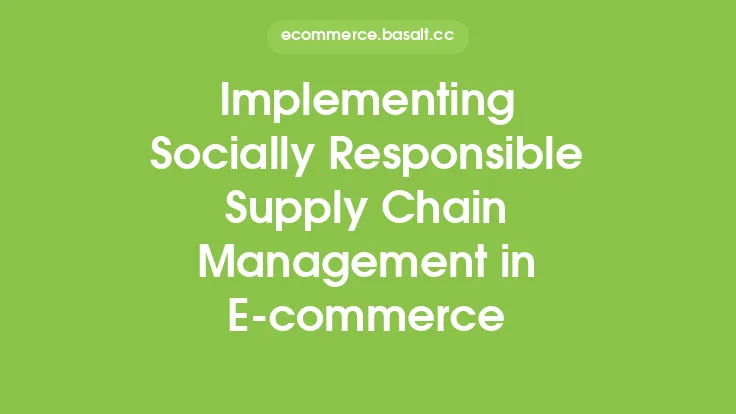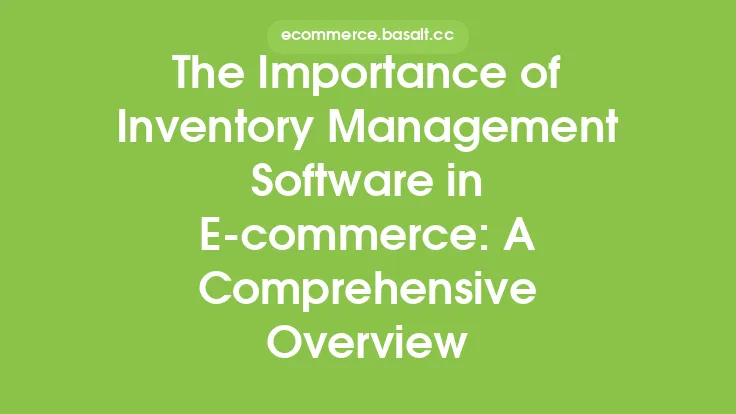In the world of e-commerce, the supply chain is the backbone that supports the entire operation. It encompasses everything from sourcing raw materials to delivering the final product to the customer's doorstep. Understanding the basics of supply chain management is crucial for any e-commerce business, as it directly impacts the company's ability to deliver products efficiently, effectively, and at a low cost. In this article, we will delve into the fundamental concepts of supply chain management, exploring its key components, types, and importance in the e-commerce industry.
Introduction to Supply Chain Management
Supply chain management refers to the coordination and management of activities involved in sourcing, producing, and delivering products to customers. It involves the flow of goods, services, and information from raw materials to end customers, and it requires the integration of multiple stakeholders, including suppliers, manufacturers, logistics providers, and retailers. Effective supply chain management enables companies to reduce costs, improve quality, and increase customer satisfaction, ultimately leading to a competitive advantage in the market.
Key Components of Supply Chain Management
The supply chain consists of several key components, including:
- Sourcing: This involves identifying and selecting suppliers who can provide high-quality raw materials or products at competitive prices.
- Manufacturing: This stage involves transforming raw materials into finished products, which can be done in-house or through contract manufacturing.
- Inventory management: This involves managing the stock levels of raw materials, work-in-progress, and finished goods to ensure that products are available when needed.
- Logistics: This includes the transportation, storage, and handling of products from the manufacturer to the customer.
- Distribution: This involves getting the products to the customer, either through a retail network or direct-to-consumer shipping.
- Returns: This involves managing the reverse flow of products, including returns, repairs, and refunds.
Types of Supply Chain Management
There are several types of supply chain management, including:
- Make-to-stock (MTS): This involves producing products in advance of demand and storing them in inventory until they are sold.
- Make-to-order (MTO): This involves producing products only after receiving a customer order.
- Assemble-to-order (ATO): This involves assembling products from pre-made components after receiving a customer order.
- Just-in-time (JIT): This involves producing and delivering products just in time to meet customer demand, with minimal inventory levels.
Importance of Supply Chain Management in E-commerce
Supply chain management is critical in e-commerce, as it directly impacts the customer experience, operational efficiency, and profitability of the business. A well-managed supply chain enables e-commerce companies to:
- Improve delivery times: By optimizing logistics and transportation, companies can reduce delivery times and improve customer satisfaction.
- Increase product availability: By managing inventory levels effectively, companies can ensure that products are available when customers need them.
- Reduce costs: By streamlining operations and minimizing waste, companies can reduce costs and improve profitability.
- Enhance customer experience: By providing accurate and timely information about product availability and delivery, companies can improve customer satisfaction and loyalty.
Best Practices for Supply Chain Management
To achieve effective supply chain management, e-commerce companies should follow best practices such as:
- Collaborating with suppliers: Building strong relationships with suppliers can help companies to negotiate better prices, improve quality, and reduce lead times.
- Implementing inventory management systems: Using inventory management systems can help companies to track stock levels, optimize inventory, and reduce waste.
- Investing in logistics and transportation: Investing in logistics and transportation can help companies to reduce delivery times, improve product availability, and increase customer satisfaction.
- Monitoring and analyzing performance: Monitoring and analyzing supply chain performance can help companies to identify areas for improvement, reduce costs, and improve efficiency.
Conclusion
In conclusion, understanding the basics of supply chain management is essential for e-commerce businesses to deliver products efficiently, effectively, and at a low cost. By grasping the key components, types, and importance of supply chain management, companies can improve delivery times, increase product availability, reduce costs, and enhance customer experience. By following best practices such as collaborating with suppliers, implementing inventory management systems, investing in logistics and transportation, and monitoring and analyzing performance, e-commerce companies can achieve effective supply chain management and gain a competitive advantage in the market.





